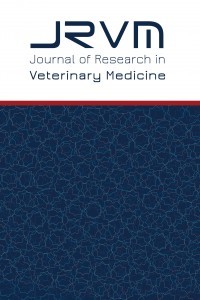Atlarda Stereotipik Davranışlar
Stereotipik davranış, at, stres
Atlarda Stereotipik Davranışlar
-,
___
- Cooper J.J., Mason G.J., 1998. The identification of abnormal behaviour and behaviour problems in stabled horses and their relationship to horse welfare: a comparative review. Eq Vet J Suppl, 27, 5–9.
- Dodman N.H., Shuster L., Patronek G.J., Kinney L., 2004. Pharmacologic treatment of equine self- mutilation. Intern. J Appl Res Vet Med 2, 90–98.
- Fjeldborg J., 1993. Results of surgical-treatment of cribbing by neurectomy and myectomy. Equine Pract, 15, 34–36.
- Frauenfelder H., 1981. Treatment of crib-biting: a surgical approach in the standing horse. Equine Vet J, 13, 62–63.
- Goldberger E., Rapoport J.L, 1991. Canine acral lick dermatitis: Response to the anti-obsessional drug clomipramine. JAAHA, 27, 179-182.
- Houpt K.A, 1986. Stable vices and trailer problems. Vet Clin North Am: Equine Pract, 2, 623–644.
- Houpt, K.A., Mc Donnell, S.M., Ralston, S., 1996. Equine stereotypies. In: Voith, V.L., Borchel, P.L. (Eds.), Readings in companion animal behavior. Veterinary Learning Systems, New Jersey, 159–166.
- Luescher U., McKeown D.B., Halip J., 1991. Reviewing the causes of obsessive-compulsive disorders in horses. Vet Med, 86, 527–531.
- Luescher U.A., McKeown D.B., Dean H., 1998. A cross-sectional study on compulsive behaviour (stable vices) in horses. Eq Vet J Suppl, 27, 14– 18.
- Seskel K., Lindeman M.J., 2001. Use of clomipramine in treatment of obsessive– compulsive disorder, separation anxiety and noise phobia in dogs: a preliminary, clinical study. Aust Vet J, 79, 252–256.
- Dodman, N.H., Shuster, L., 1998. Psychopharmacology of Animal Behavior Disorders, Blackwell Science.
- McAfee L.M., Mills D.S., Cooper J.J., 2002. The use of mirrors for the control of stereotypic weaving behavior in stabled horse. Appl Anim Beh Sci, 78, 159-173.
- McBride S.D., Cuddeford D., 2001. The putative welfare reducing effects of preventing equine stereotypical behavior. Anim Welf 10, 173-189.
- McDonnell S.M., 2008. Practical review of self- mutilation of horses. Anim Repr Sci, 107(3-4), 219-228.
- McGreevy P., Cripps P.J., French N.P., Green L.E., Nicol C.J., 1995. Management factors associated with stereotypic and redirected behaviour in the thoroughbred horse. Eq Vet J, 27(2), 86–91.
- McGreevy P., 2004. Equine behavior: a guide for veterinarians and equine scientists, Saunders.
- Mills D.S., Nankervis K., 1999. Equine behaviour: principles and practice. Oxford: Blackwell Science.
- Nagy K., Bodo G., 2009. Aetiology and treatment of crib-biting/wind-sucking in horses: new oppurtunities. Magyar Allatorvosok Lapj, 131(1), 8-16.
- Nicol C.J., Davidson H.P., Harris P.A., Waters A., Wilson A.D., 2002. Study of crib-biting and gastric inflammation and ulseration in young horses. Vet Rec, 151(22), 658-662.
- Ralston S.L., 1982. Common behavioral problems of horses. Comp Cont Educ Pract Vet, 4, 152– 159.
- Waters A., Nicol C.J., French N.P., 2002. Factors
- influencing the development of stereotypic and redirected behaviours in young horses: findings of a four year prospective epidemiological study. Equine Vet J, 34(6), 572-579.
- Başlangıç: 1981
- Yayıncı: Bursa Uludağ Üniversitesi
Karkaslarda Elektriksel Stimülasyon Uygulamaları
Bir Kuzuda İdrar Kesesi Rupturu
Hakan SALCI, G. Ülke ÇALIŞKAN, Göksen ÇEÇEN, Nureddin ÇELİMLİ, O. Sacit GÖRGÜL
Seher KÜÇÜKERSAN, Derya YEŞİLBAĞ, Kemal KÜÇÜKERSAN, Ebru GÖNCÜOĞLU
A Perspective On The Potential Health Risks Of Dioxin In Human Food
Atlarda Stereotipik Davranışlar
Bir Köpekte Malignant Perikardiyal Mezotelyoma ve Perikardiyal Efüzyon
Meriç KOCATURK, Hakan SALCI, Aylin ALASONYALILAR, - DEMİRER, Nureddin ÇELİMLİ
Sığırlarda Embriyo Transfer Uygulaması ve Türkiye Açısından Önemi
Bir Buzağıda Konjenital Rektovajinal Fistül
Hakan SALCI, G. Ülke ÇALIŞKAN, Göksen ÇEÇEN, Nureddin ÇELİMLİ, Elçin BATMAZ, O. Sacit GÖRGÜL
